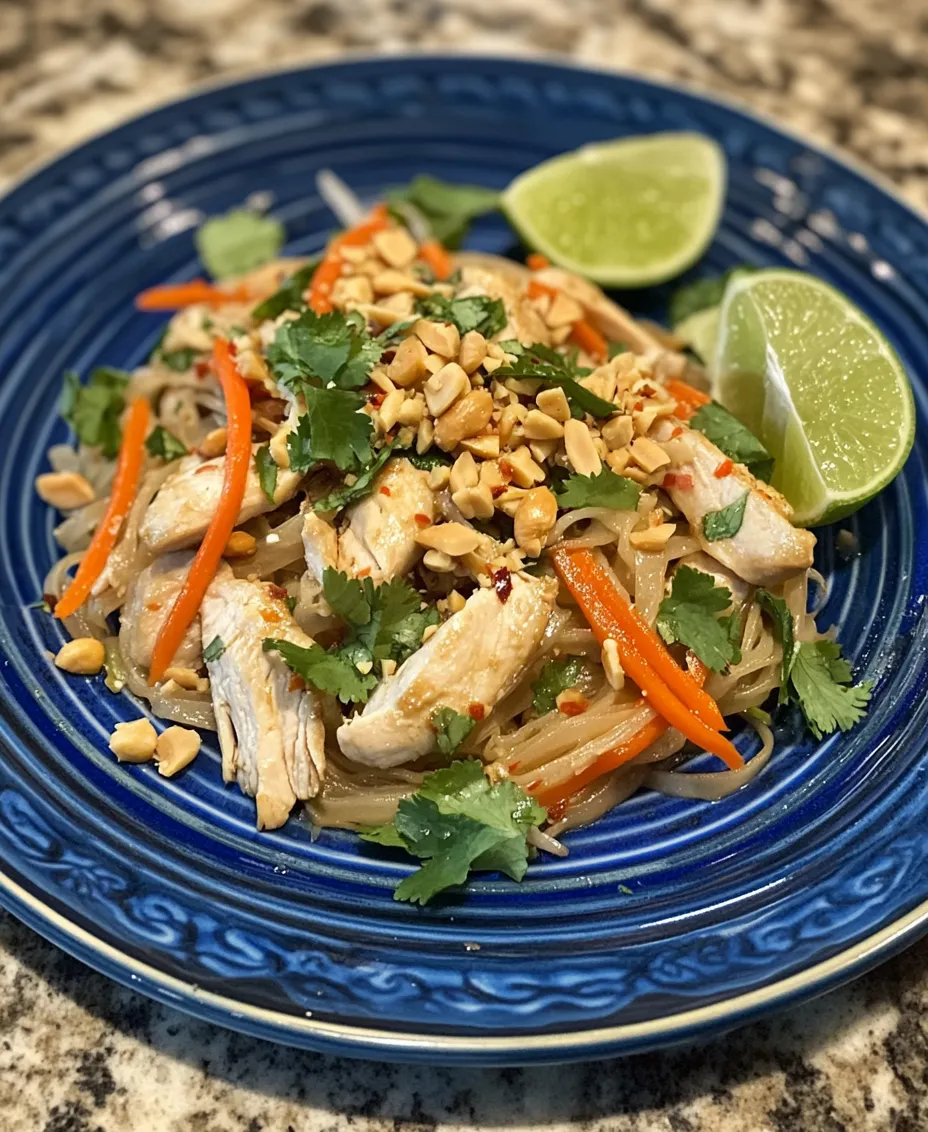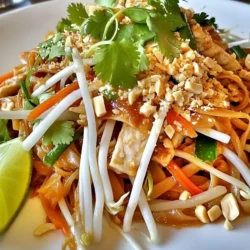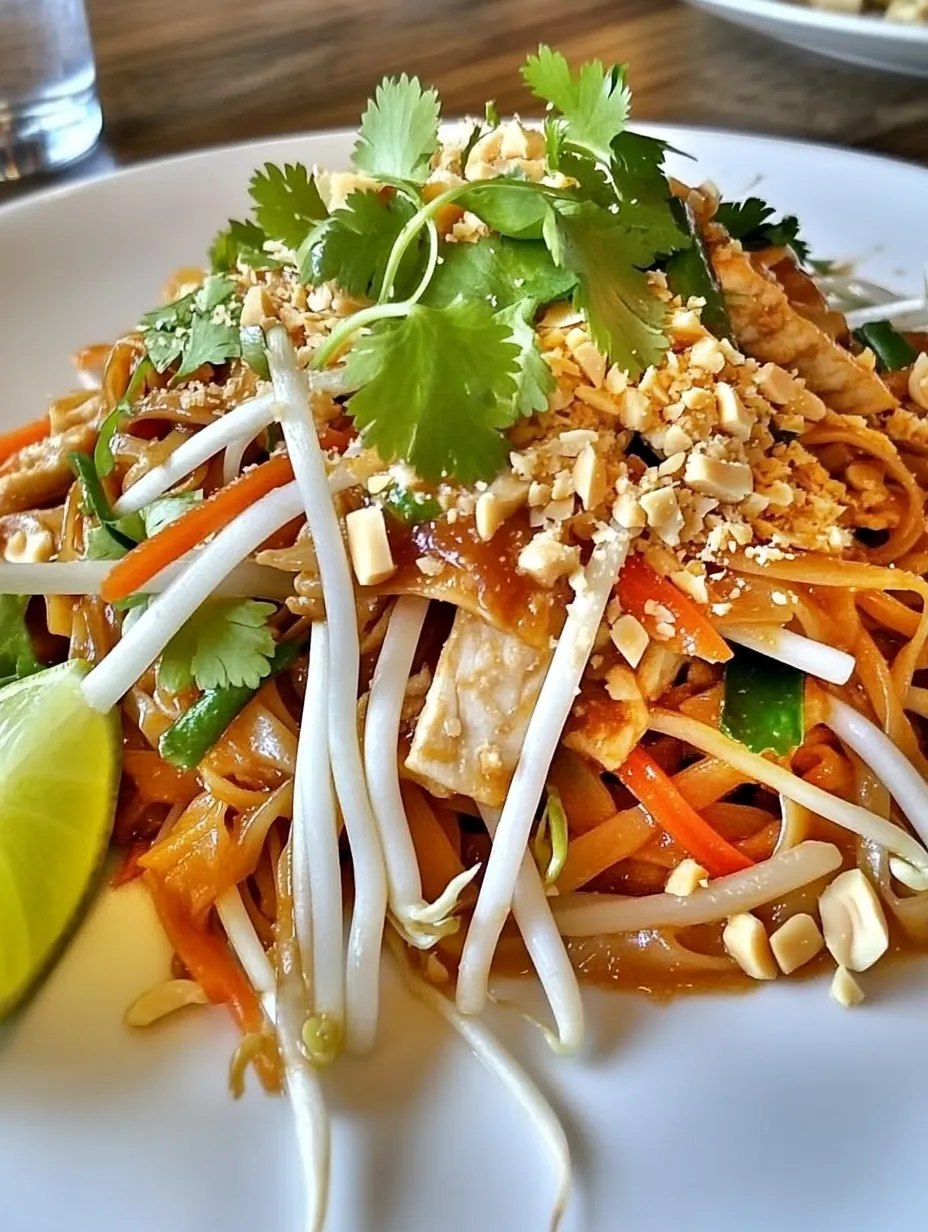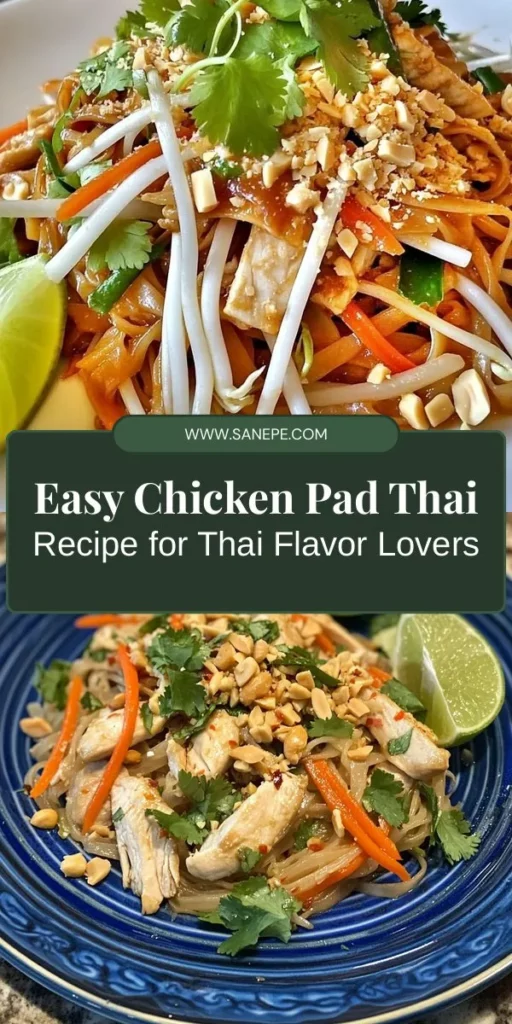Introduction
Pad Thai is undoubtedly one of the most famous dishes to emerge from Thai cuisine, celebrated for its harmonious blend of flavors and textures. This stir-fried noodle dish is not only a favorite among locals but has also captured the hearts and palates of food lovers around the world. Known for its vibrant presentation and a perfect balance of sweet, salty, and sour notes, Pad Thai offers a delightful experience that showcases the essence of Thai cooking. In this article, we will dive into the intricacies of preparing “Wok It Out Chicken Pad Thai,” a recipe that emphasizes the use of fresh ingredients and authentic flavors to recreate the traditional dish right in your home kitchen.
Using fresh ingredients is paramount when making Pad Thai. The quality of each component can significantly influence the overall taste and authenticity of the dish. From the rice noodles to the boneless chicken breast and an array of colorful vegetables, every ingredient plays a crucial role in delivering that classic Pad Thai experience. This recipe will guide you through the process, ensuring that you can whip up a delicious and satisfying plate of chicken Pad Thai that rivals those found in street food stalls across Thailand.
The Essence of Pad Thai
Historical Background of Pad Thai
Pad Thai, which translates to “Thai-style fried noodles,” has a rich history that dates back to the 1930s. It was during this time that the Thai government, under Prime Minister Plaek Phibunsongkhram, sought to promote a national identity and unity among its citizens. The dish was popularized as part of a campaign to encourage Thais to consume more noodles, which were seen as a symbol of modernity. This culinary initiative helped transform Pad Thai from a simple street food into a national dish that reflects both Thai culture and global influence.
Significance in Thai Culture and Cuisine
In Thailand, Pad Thai is more than just a meal; it is a symbol of the country’s culinary heritage. The dish combines influences from Chinese cooking—particularly the stir-frying technique—with traditional Thai flavors and ingredients. It embodies the balance of the four fundamental flavors in Thai cuisine: sweet, sour, salty, and bitter. This balance is not only critical to the taste of Pad Thai but also serves as a representation of the Thai philosophy of harmony in food and life.
Common Variations and Adaptations of Pad Thai
While the traditional Pad Thai recipe typically features shrimp or chicken, there are numerous variations that cater to different dietary preferences and regional tastes. Vegetarian and vegan versions replace the meat with tofu or a medley of vegetables, while seafood lovers might opt for a combination of shrimp, squid, and fish. Additionally, some recipes may include unique ingredients such as tamarind paste, lime juice, or even peanut sauce to create distinct flavor profiles. Regardless of the variation, the core elements of Pad Thai remain intact, showcasing the dish’s versatility and adaptability.
Ingredient Breakdown
Overview of Key Ingredients Used in the Recipe
To create an authentic Wok It Out Chicken Pad Thai, you’ll need to gather a selection of key ingredients that contribute to its signature flavor and texture. Below is a breakdown of each component:
– Rice Noodles: The foundation of any Pad Thai, rice noodles are essential for achieving the dish’s beloved chewy texture. They are available in various widths, and for this recipe, medium-sized rice noodles are preferred.
– Boneless Chicken Breast: This lean source of protein is a popular choice for Pad Thai, providing a hearty element without excessive fat. It absorbs flavors well and complements the other ingredients beautifully.
– Fresh Vegetables: A colorful array of vegetables, such as bean sprouts, scallions, carrots, and bell peppers, not only adds nutritional value but also enhances the visual appeal of the dish.
– Sauces and Seasonings: The distinctive Pad Thai sauce is a crucial component, typically made from tamarind paste, fish sauce, sugar, and chili powder. This combination of ingredients creates the perfect balance of sweet, salty, and sour flavors that define the dish.
Importance of Each Ingredient in Achieving Authentic Flavor
Each ingredient in Pad Thai plays a vital role in building its complex flavor profile. Freshness is key; using high-quality, fresh ingredients ensures that your dish will taste authentic and vibrant. Rice noodles should be cooked just right to maintain their texture, while the chicken must be tender and juicy. Vegetables not only add a pop of color but also contribute to the dish’s overall nutrition and flavor. The sauces and seasonings, carefully balanced, bring the entire dish to life, making it a delightful culinary experience.
Rice Noodles: Types and How They Contribute to Texture
When it comes to rice noodles, there are several types available, including thin, medium, and wide variations. Medium rice noodles, often referred to as “sen lek,” are the preferred choice for Pad Thai due to their ideal texture and ability to hold onto the sauce without becoming mushy. Cooking the noodles properly—soaking them until they are pliable yet firm—ensures that they maintain their structure throughout the stir-frying process, resulting in a perfect bite every time.
Boneless Chicken Breast: Lean Protein Choice and Its Benefits
Boneless chicken breast is an excellent protein option for Pad Thai, as it is low in fat and high in protein. This lean meat absorbs flavors from the marinade and sauces, making it an ideal choice for this dish. Additionally, chicken breast cooks quickly and can be easily sliced into thin strips, ensuring even cooking during the stir-frying process. Its neutral flavor allows it to complement the bold taste of the Pad Thai sauce without overpowering it.
Fresh Vegetables: Nutritional Value and Color Contrast
Incorporating fresh vegetables into your Pad Thai not only enhances its nutritional profile but also adds a burst of color and texture. Bean sprouts provide a crunchy element, while scallions and carrots offer a mild sweetness. Bell peppers can introduce a touch of sweetness and a vibrant hue, making your dish visually appealing. These vegetables contribute essential vitamins and minerals, ensuring that your meal is not only delicious but also wholesome.
Sauces and Seasonings: Balancing Sweet, Salty, and Sour
The Pad Thai sauce is the heart of the dish, and achieving the right balance between sweet, salty, and sour is crucial. Tamarind paste gives Pad Thai its characteristic tanginess, while fish sauce adds depth and umami. Sugar balances the sourness of the tamarind, creating a harmonious flavor profile. To elevate the dish, a touch of chili powder can be added to introduce a gentle heat. The key is to taste and adjust the sauce to your preference, ensuring that each bite is a delightful explosion of flavor.
Preparation Steps for a Perfect Pad Thai
Detailed Preparation of Rice Noodles
To begin your Wok It Out Chicken Pad Thai, the first step is to prepare the rice noodles. Start by selecting high-quality medium rice noodles from your local Asian grocery store or supermarket. Place the noodles in a large bowl and cover them with hot water. Allow them to soak for about 20-30 minutes, or until they become soft yet slightly firm to the bite. Avoid boiling the noodles, as this can lead to a mushy texture.
Once the noodles have softened, drain them in a colander and rinse them under cold water. This stops the cooking process and prevents them from sticking together. Toss the noodles with a little bit of oil to keep them separate and set them aside while you prepare the rest of the ingredients.
How Soaking Noodles Affects Texture and Flavor
Soaking the rice noodles is an essential step in ensuring that they achieve the perfect texture. If cooked directly in boiling water, they can easily become overcooked and lose their desirable chewiness. Soaking allows the noodles to absorb moisture gradually, leading to a more controlled cooking process during stir-frying. This method also enhances the noodles’ ability to soak up the Pad Thai sauce, resulting in a flavorful dish that is not overly saucy.
Cooking the Chicken: Tips for Achieving the Right Doneness
While the noodles soak, you can move on to preparing the chicken. Start by slicing boneless chicken breast into thin strips, making it easier to cook quickly and evenly. Heat a tablespoon of vegetable oil in a large wok or non-stick skillet over medium-high heat. Once the oil is hot, add the sliced chicken and season it with a pinch of salt and pepper.
Cook the chicken for about 4-5 minutes, stirring frequently to ensure even browning. The goal is to achieve a golden color on the outside while ensuring the inside remains juicy and tender. To check for doneness, cut a piece of chicken in half; it should be opaque and no longer pink. Once cooked, remove the chicken from the wok and set it aside, allowing it to rest before adding it back to the dish later.
Sautéing Aromatics: The Role of Garlic in Flavor Development
With the chicken cooked, it’s time to add aromatics to the wok. Add another tablespoon of oil if necessary and toss in minced garlic. Sauté the garlic for about 30 seconds, or until it becomes fragrant but not browned. Garlic is a quintessential ingredient in many Asian dishes, known for its ability to enhance the overall flavor profile.
As the aroma fills the kitchen, you’ll notice how this step elevates your Pad Thai. The flavor of the garlic melds beautifully with the chicken and the upcoming vegetables, setting the stage for a delicious stir-fry. After sautéing the garlic, you can proceed to add in the prepared vegetables and the soaked rice noodles to create the foundation of your Wok It Out Chicken Pad Thai.
By following these initial steps, you are well on your way to mastering a delightful Pad Thai that encapsulates the essence of Thai cuisine. Stay tuned as we delve deeper into the remaining steps and tips to create a truly unforgettable dish.

Scrambling Eggs: Incorporating Protein and Richness into the Dish
To achieve the authentic texture and flavor of Wok It Out Chicken Pad Thai, start by scrambling the eggs. Heat a tablespoon of oil in your hot wok over medium-high heat. Once the oil is shimmering, crack in two large eggs. Allow them to sit for a few seconds before gently stirring with a spatula. The goal is to create soft, creamy curds, which will add both protein and richness to your dish. As the eggs begin to set, continue to stir until they’re just cooked through, then transfer them to a plate and set aside. This technique ensures the eggs remain fluffy and light, integrating seamlessly into the vibrant mix of flavors in your Pad Thai.
Adding Vegetables: Timing and Technique for Stir-Frying
Next, it’s time to bring in a medley of fresh vegetables, enhancing the nutritional profile and adding a burst of color. Start with about one cup of thinly sliced bell peppers, one carrot julienned, and a handful of bean sprouts. The timing of adding these vegetables is crucial to maintaining their crunch and vibrant colors.
Return the wok to the heat and add another tablespoon of oil if necessary. Once hot, toss in the bell peppers and carrots, stirring quickly for about two minutes. You want these vegetables to be tender yet still crisp. After two minutes, add the bean sprouts and stir-fry for an additional minute. This technique ensures that the vegetables retain their texture and freshness, providing a delightful contrast to the chewy rice noodles.
Combining Ingredients: Importance of Sauce Distribution
With the vegetables perfectly stir-fried, it’s time to combine all components. Add the cooked rice noodles to the wok, followed by the scrambled eggs. Now, pour in the prepared Pad Thai sauce—typically a mixture of tamarind paste, fish sauce, sugar, and lime juice. This sauce is the heart of the dish, delivering that signature sweet, sour, and savory flavor profile.
To ensure even distribution of the sauce, use your spatula to gently toss the noodles, vegetables, and eggs together. It’s important to mix thoroughly, allowing the noodles to soak up the sauce while ensuring that each ingredient is coated. This step is crucial for achieving a well-balanced flavor in every bite. Cook for an additional minute or two, allowing the noodles to heat through and the flavors to meld beautifully.
Final Steps to Complete the Dish: Adding Chicken and Garnishing
Now that your Pad Thai is almost complete, it’s time to add the star of the show—chicken. If you haven’t done so already, thinly slice your cooked chicken breast or thigh into bite-sized pieces. Add it to the wok and gently fold it into the noodles and vegetables, cooking just until heated through.
For a finishing touch, garnish your Wok It Out Chicken Pad Thai with crushed peanuts, fresh cilantro, and lime wedges. The peanuts add a delightful crunch, while the cilantro brings a burst of freshness. Squeeze lime juice over the dish just before serving for an extra zing. Your Chicken Pad Thai is now ready to be enjoyed!
Nutritional Analysis
Understanding the nutritional content of your Wok It Out Chicken Pad Thai can help you appreciate the health benefits of this dish.
Caloric Breakdown of Wok It Out Chicken Pad Thai
A standard serving of Chicken Pad Thai contains approximately 450-600 calories, depending on the portion size and specific ingredients used. Most of the calories come from carbohydrates, primarily from the rice noodles.
Health Benefits of the Ingredients Used
This dish is packed with nutrients. The vegetables provide a variety of vitamins and minerals essential for maintaining good health. The chicken serves as a rich source of lean protein, which is vital for muscle growth and repair.
Lean Protein Sources and Vegetable Intake
Using chicken breast is an excellent choice for lean protein, contributing to a filling meal without excess fat. Including a variety of vegetables not only enhances the dish’s flavor but also boosts fiber content, which is beneficial for digestion.
Healthy Fats from Peanuts
Peanuts add healthy fats, protein, and a satisfying crunch to the dish. They are also a good source of antioxidants and have been linked to heart health.
Suggestions for Making the Dish Lighter or Vegan-Friendly
To lighten the dish, consider using less oil and opting for whole grain rice noodles. For a vegan version, simply replace the chicken with tofu or tempeh, and use soy sauce instead of fish sauce in the Pad Thai sauce. You can also skip the eggs or replace them with a scrambled tofu mixture for a similar texture.
Serving Suggestions
Presentation Tips for an Appealing Dish
Presentation plays a key role in making your Wok It Out Chicken Pad Thai visually appealing. Serve the Pad Thai in a large bowl or on a plate, and arrange it neatly. Garnish with extra crushed peanuts, a sprinkle of fresh cilantro, and lime wedges on the side. This not only enhances the look but also makes it easy for diners to add lime juice according to their preference.
Best Accompaniments for Pad Thai
Pad Thai is a versatile dish that pairs well with various sides. Consider serving it alongside a fresh cucumber salad or a light soup, such as Tom Yum, to balance the meal. For added flavor, you might also offer chili flakes or Sriracha on the side for those who enjoy a spicy kick.
Ideal Beverages to Pair with Chicken Pad Thai
When it comes to beverages, a cold Thai iced tea or a light beer can beautifully complement the flavors of Chicken Pad Thai. Alternatively, serve it with a refreshing mocktail made from lime, mint, and soda water for a non-alcoholic option.
Cultural Context of Pad Thai
Regional Variations of Pad Thai Across Thailand
Pad Thai is not just a single recipe; it has numerous regional variations throughout Thailand. In the north, you may find Pad Thai with a sweeter sauce, while southern versions often incorporate more seafood. Each region adds its own twist, influenced by local ingredients and culinary traditions.
How Pad Thai Has Been Embraced Globally
Since its creation, Pad Thai has transcended borders, becoming a beloved dish worldwide. Its balance of flavors and textures appeals to a broad audience, making it a staple in Thai restaurants globally. The dish’s fame has led to various adaptations, including vegetarian, vegan, and gluten-free versions, catering to diverse dietary preferences.
The Dish’s Role in Thai Street Food Culture
Pad Thai is often associated with Thai street food culture, where vendors serve it quickly and efficiently to hungry diners. This dish represents the heart of Thai cuisine—flavorful, quick to prepare, and easily enjoyed on the go. The vibrant street food scene is an essential aspect of Thailand’s culinary identity, and Pad Thai stands out as a symbol of this rich tradition.
Conclusion
Wok It Out Chicken Pad Thai is a delightful dish that encapsulates the vibrant flavors and textures of Thai cuisine. The combination of tender chicken, fresh vegetables, and a tangy sauce creates an experience that is both satisfying and nourishing. Making this dish at home allows you to control the ingredients and customize it to your taste, offering a fulfilling cooking adventure.
As you explore this recipe, remember that cooking is not just about the food but also about the joy of sharing it with others. Invite family and friends to join you in the kitchen or enjoy your Pad Thai together at the dinner table. Embrace the process, savor the flavors, and appreciate the rich culinary traditions that make Thai cuisine so special. Whether you’re a seasoned cook or a novice in the kitchen, Wok It Out Chicken Pad Thai is sure to become a cherished addition to your recipe collection.


